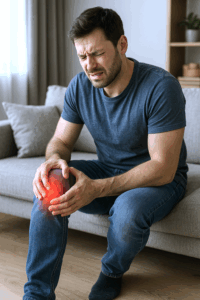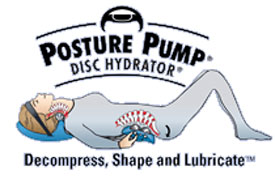Knee Pain: What Families Need to Know About Prevention and Relief
Knee pain is one of those silent disruptors that creeps into our lives when we least expect it, often becoming a shared concern within families.
 Whether you’re a parent trying to keep up with your kids, a professional balancing a busy work schedule, or caring for aging parents, knee pain can affect everyone. It can limit our ability to move comfortably, impacting not just workouts but our capacity to perform day-to-day activities—whether it’s running errands, walking, or simply climbing stairs. Understanding the causes of knee pain and how to prevent and manage it is essential for keeping ourselves and our loved ones active and healthy.
Whether you’re a parent trying to keep up with your kids, a professional balancing a busy work schedule, or caring for aging parents, knee pain can affect everyone. It can limit our ability to move comfortably, impacting not just workouts but our capacity to perform day-to-day activities—whether it’s running errands, walking, or simply climbing stairs. Understanding the causes of knee pain and how to prevent and manage it is essential for keeping ourselves and our loved ones active and healthy.
Why Are Knees So Prone to Pain?
The knee joint is remarkable for its strength and mobility, carrying our body weight and facilitating movement throughout our daily lives. But because it’s so heavily used, the knee is especially vulnerable to injury and wear. From the bumps and bruises of an active child to the degenerative conditions that may affect aging parents, knee pain can affect all generations in a family. Below, we explore common types of knee problems, their causes, and effective solutions.
Common Types of Knee Pain in Families
- Temporary and Self-Healing Knee Issues
These are the types of knee pain that typically resolve with a bit of rest and care. They often arise from minor incidents—such as your child’s fall at the playground or your spouse twisting their knee while exercising. Examples include:
- Bruises or minor swelling from everyday bumps.
- Minor strains of the muscles or ligaments attached to the knee.
These issues usually resolve themselves with time and simple home treatments like rest, ice, and elevation.
- Functional Knee Problems Manageable with Conservative Treatment
More persistent knee issues often develop due to overuse or improper movement patterns, which can be exacerbated by the demands of family life, whether it’s hours spent seated at a desk, standing on the job, or running around after children. Conditions in this category include:
- Patella bursitis: This is inflammation in front of the knee joint, commonly experienced by people who spend long periods sitting or kneeling.
- Lateral ligament strains: Pain on the outer side of the knee, which might happen after a family hike or strenuous yard work.
- Tight ligaments: Long hours of sitting, especially in professions that require office work, can lead to tight muscles around the knee joint, increasing the risk of pain and strain.
These issues are often managed effectively with non-invasive treatments, such as bracing, targeted stretching, and chiropractic care. Early intervention is key to preventing these conditions from becoming more severe.
- Serious Knee Issues Requiring Orthopedic Care or Surgery
Sometimes, knee pain signals a more significant problem, such as a serious injury from sports, accidents, or aging-related degeneration. These conditions include:
- Torn cartilage or meniscus: Common in aging adults or athletes in the family.
- Torn ligaments: Injuries to ligaments in and around the knee, which often require medical intervention.
- Fractures: Sudden trauma from a fall or accident, especially common in older adults, may lead to fractures that require surgical care.
For these more severe conditions, timely orthopedic consultation is essential, and in some cases, surgery may be necessary.
Three Simple Ways to Relieve Knee Pain at Home
If you or a family member experiences knee pain that falls into the first two categories, there are some simple at-home remedies that can help alleviate discomfort:
- Ice for Swelling and Inflammation
Whether it’s your child’s bruised knee or your spouse’s post-workout pain, applying ice can significantly reduce swelling and inflammation. Apply an ice pack for 20-30 minutes, taking breaks between applications. Repeat as needed throughout the day. Ice therapy is especially useful after physical activity or for acute pain. Follow the 20-2x-2w rule of applying ice 20 minutes over the knee 2x/day for 2 weeks.
- Bracing for Support
Using an elastic knee brace or sports bandage offers extra support and can help control swelling during daily activities. This can be particularly helpful if you or your loved one needs to stay active while healing from a minor strain. However, it’s crucial to consult a healthcare professional to ensure you’re using the appropriate type of brace and avoiding complications from long-term use.
- Stretching and Strengthening
Tight hamstrings and calf muscles often contribute to knee pain, particularly in adults who spend long periods sitting or standing. Regular stretching can relieve tension in these muscles, reducing strain on the knee. Encourage your family to incorporate stretching exercises into their daily routines, especially before and after physical activity.
Preventing Knee Pain: A Family Approach
Preventing knee pain goes beyond just protecting against injury. It’s about adopting a holistic approach that considers overall posture, spinal health, and muscle conditioning for each family member. Knee pain can often be linked to poor posture or spinal misalignments that interfere with nerve function, particularly in adults who sit for long hours or perform repetitive motions. Supporting your family in staying active, maintaining good posture, and receiving regular chiropractic care can make a significant difference in reducing the risk of knee pain.
Chiropractic Care and Knee Pain
If knee pain becomes a recurring issue in your household, it may be time to consider chiropractic care. Misalignments in the spine can lead to nerve interference that exacerbates or even causes knee pain. Chiropractors work to realign the spine and restore proper nerve function, addressing the root cause of many musculoskeletal issues, including knee pain.
When to Seek Professional Help
For minor knee pain, home treatments can be very effective, but persistent or severe pain should not be ignored. If anyone in your family is dealing with long-term discomfort, decreased mobility, or swelling that doesn’t improve with rest, consult a healthcare professional such as a chiropractor to ensure an accurate diagnosis and personalized treatment plan.
In conclusion, knee pain is a common issue that affects people of all ages from young children to aging parents. By being proactive with prevention, maintaining good posture, and addressing pain early with appropriate treatments, you can help ensure that your family stays active, healthy, and pain-free. Chiropractic care can play a vital role in managing and preventing knee pain by focusing on spinal health and holistic body mechanics.
References
- American Chiropractic Association. Understanding the Link Between Posture and Knee Pain. https://www.acatoday.org/
- Harvard Health Publishing. Knee Pain: Causes, Symptoms, and Treatment. https://www.health.harvard.edu/pain/knee-pain
- National Institute on Aging. Aging and Your Knees: Joint Health in Older Adults. https://www.nia.nih.gov/health/joint-health
- Mayo Clinic. Torn Meniscus: Symptoms and Treatment. https://www.mayoclinic.org/diseases-conditions/torn-meniscus



No Comments